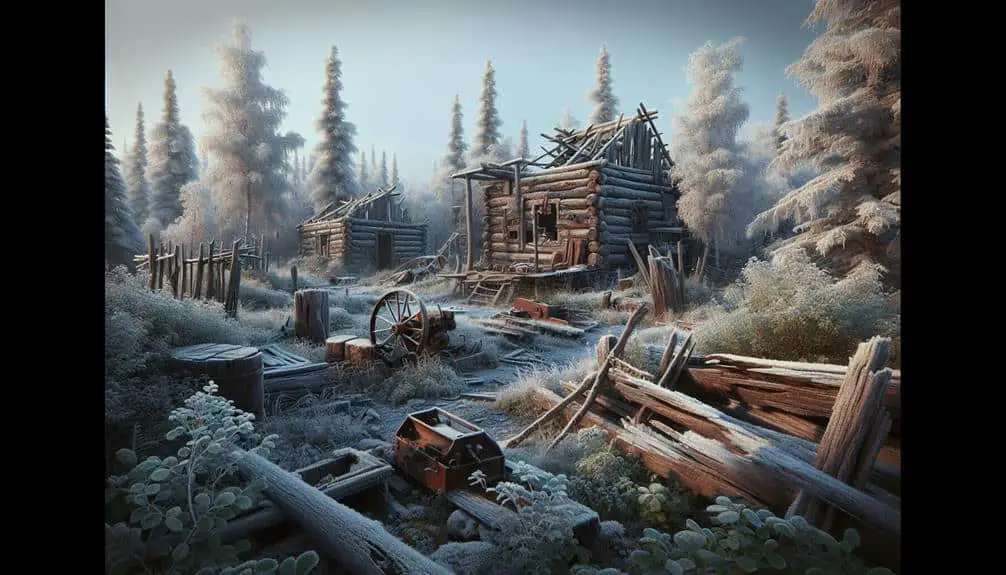Discover the forgotten fur trading outposts like Trappers Point and Fort Lisa, where bustling commerce and cultural exchange once thrived. Explore the architectural marvels and vanishing presence of Fort Nez Percés and the strategic legacy of Fort Okanogan. Encounter the echoes of the past at Fort Cass with its preserved artifacts and historical significance. Unearth the rich history of these outposts, each holding a unique tale from the fur trade era.
Key Points
- Trappers Point and Fort Nez Percés are forgotten fur trading outposts with hidden treasures.
- Fort Lisa and Fort Okanogan were once thriving fur trading posts, now abandoned legacies.
- Fort Cass stands as a preserved site with rich historical artifacts from the fur trade era.
- Fort Lisa showcases early traders' ingenuity in the wilderness.
- Fort Nez Percés' vanishing presence is obscured by erosion and nature's encroachment.
Trappers Point: A Forgotten Outpost
Trappers Point stands as a forgotten fur trading outpost, its history shrouded in the mists of time and neglect. Once a bustling hub of commerce and cultural exchange, this outpost now sits silently, its forgotten history waiting to be unearthed. Despite its obscurity, Trappers Point holds hidden treasures for those willing to explore its remnants.
The forgotten history of Trappers Point reveals tales of intrepid trappers and traders who navigated the wilderness in search of beaver pelts and other valuable furs. These pioneers braved harsh conditions and unknown territories, leaving behind a legacy that's now obscured by the passage of time.
Exploring Trappers Point today may reveal hidden treasures such as old trading posts, remnants of cabins, and perhaps even artifacts from a bygone era. These glimpses into the past offer a unique opportunity to connect with the spirit of adventure and freedom that once defined this forgotten outpost. As you wander through the quiet remnants of Trappers Point, take a moment to imagine the lives of those who once called this place home.
Fort Lisa: Lost in the Wilderness
Nestled deep within the wilderness, Fort Lisa emerges as a mysterious relic of a bygone era, its once vibrant history now obscured by the passage of time. Exploring ruins like Fort Lisa can be a fascinating journey, shedding light on historical mysteries and offering a glimpse into the past.
- Architectural Marvels: The structural design of Fort Lisa showcases the ingenuity of early fur traders, with remnants of log cabins, stockades, and trading posts providing insight into the outpost's layout.
- Trading Dynamics: Unravel the intricate web of trade agreements and interactions that once thrived within Fort Lisa, where furs, goods, and stories were exchanged among diverse groups of people.
- Wilderness Integration: Witness how Fort Lisa harmonized with the surrounding wilderness, adapting to nature's challenges and opportunities in a delicate balance.
- Legacy of Exploration: Trace the footsteps of adventurers who roamed the untamed landscapes near Fort Lisa, leaving behind a legacy of courage and discovery that echoes through the ages.
Fort Nez Percés: Vanishing Trading Post
The gradual disappearance of Fort Nez Percés, a once bustling fur trading post, raises questions about the factors contributing to its vanishing presence in the historical landscape. Established in the early 19th century, this trading post played an important role in the fur trade industry, serving as a hub for interactions between traders and the Nez Percé Native American tribe. However, over time, the fort's structures have crumbled, leaving behind only remnants of its former glory.
Ancient artifacts found in the vicinity of Fort Nez Percés have sparked archaeological mysteries, with researchers delving into the past to uncover the secrets held within the site. The gradual erosion of the fort's walls and the encroachment of nature have further obscured the historical significance of this once thriving outpost.
As you ponder the vanishing of Fort Nez Percés, contemplate the stories hidden within its ruins and the mysteries waiting to be unraveled by those who seek to preserve its legacy.
Fort Okanogan: Abandoned Legacy
The legacy of Fort Okanogan lies in the stark abandonment that now characterizes its once bustling presence in the historical narrative. Established in 1811 by the Pacific Fur Company, this fur trading post played a crucial role in the early exploration and commerce in the Pacific Northwest. However, the site now stands as a statement to the passage of time, with its abandoned ruins whispering stories of a bygone era.
Markdown List:
- Strategic Location: Fort Okanogan was strategically positioned at the confluence of the Okanogan and Columbia Rivers, allowing for easy access to trade routes and interactions with Indigenous tribes.
- Cultural Exchange: The fort facilitated cultural exchange between European traders and Native American communities, influencing traditions, languages, and economies.
- Decline and Desertion: Over time, changes in the fur trade industry and conflicts led to the decline of Fort Okanogan, eventually resulting in its abandonment.
- Historical Significance: Despite its current state of disrepair, Fort Okanogan holds immense historical significance as a symbol of early colonial presence and the complex interactions that shaped the region.
The abandoned ruins of Fort Okanogan serve as a poignant reminder of the transient nature of human endeavors and the enduring imprint of historical events on the landscape.
Fort Cass: Echoes of the Past
In the abandoned remnants of Fort Cass, vestiges of a bygone era linger, echoing tales of a once thriving fur trading outpost. Historical preservation efforts have been instrumental in safeguarding what remains of this significant site. Archaeological discoveries at Fort Cass have revealed a treasure trove of artifacts, shedding light on the daily lives and trading practices of early settlers.
The meticulous preservation of Fort Cass has allowed historians to piece together its rich history, offering a glimpse into a time when fur trading played a pivotal role in shaping the region. The site stands as a poignant reminder of the challenges and triumphs faced by those who sought their fortunes in the fur trade.
Recent archaeological excavations have unearthed a wealth of information, enabling researchers to reconstruct the layout of the fort and gain insights into its strategic importance. These discoveries not only enrich our understanding of the past but also highlight the importance of preserving historical sites for future generations to appreciate. Fort Cass serves as a proof to the enduring legacy of the fur trade in shaping the landscape of the American frontier.
Frequently Asked Questions
What Were Some of the Key Challenges Faced by Trappers and Traders at These Lost Fur Trading Outposts?
When trappers and traders are stationed at lost fur trading outposts, challenges are aplenty. Harsh climates test your endurance, affecting the isolation that engulfs you. The struggle is real, but the thrill of adventure persists.
How Did the Decline of the Fur Trade Industry Contribute to the Abandonment of These Outposts?
As the fur trade declined, its effects were felt in the abandonment of outposts. The economic impact led to closures, leaving these once thriving hubs desolate. Trappers and traders faced challenges, but the decline hastened their demise.
What Role Did Native American Tribes Play in the History of These Fur Trading Outposts?
You might think Native American tribes had a minor role in fur trading outposts, but in reality, their deep connections influenced trade dynamics. Cultural exchange between tribes and traders shaped the history of these posts considerably.
Are There Any Efforts Being Made to Preserve or Restore These Lost Outposts for Historical Purposes?
Preservation efforts for historical significance are underway. Organizations and communities collaborate to restore lost outposts. Through these initiatives, the past comes alive, connecting people to the rich heritage of fur trading outposts.
What Impact Did the Closure of These Outposts Have on the Surrounding Communities and Economies?
When the outposts closed, communities felt the sting of economic downturn. Businesses faltered, families struggled, and hope dwindled. The impact on communities was profound, leaving scars of loss that still linger today.



